Cutlass Power-Lock-Hub
THIS WEB PAGE WAS A FAMILY PROJECT
Text by: Rick Stivers
Photos by: Stephanie Stivers age 12
This is the Cutlass Power-Lock-Hub (PLH). Cutlass Tool and Mfg. Co Lyons Ill
manufactured them. I have been unable to locate this company so it seems that they have
either gone out of business or merged with some other company. If you locate this company,
please contact me so that I can update this page.
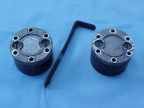 The PLH is
locked and unlocked using the angled tool in the picture known a control key. Each end of
the tool is rounded to fit into the curved slots in the top of each locking pin on the
hub. The locking pins have arrows to determine if they are locked or unlocked. When the
arrows point out the hub is unlocked, when they point in it is locked. The hubs should be
locked before engaging the four-wheel drive so that the axle shaft can be turned
internally. Failure to lock the hubs prior to engaging the four-wheel drive usually causes
the hub to bind and prevents locking. The Hub has these instructions printed on the face:
The PLH is
locked and unlocked using the angled tool in the picture known a control key. Each end of
the tool is rounded to fit into the curved slots in the top of each locking pin on the
hub. The locking pins have arrows to determine if they are locked or unlocked. When the
arrows point out the hub is unlocked, when they point in it is locked. The hubs should be
locked before engaging the four-wheel drive so that the axle shaft can be turned
internally. Failure to lock the hubs prior to engaging the four-wheel drive usually causes
the hub to bind and prevents locking. The Hub has these instructions printed on the face:
" IMPORTANT
SHIFT TRANSFER CASE TO 2 WHEEL DRIVE
& TRANSMISSION TO NEUTRAL
DIRECTION OF ARROWS
3 2 WHEEL DRIVE 4
4 4 WHEEL DRIVE 3
" |
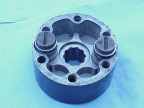 With the hub's cover removed it is easy to see the locking pins in the locked position.
With the hub's cover removed it is easy to see the locking pins in the locked position.
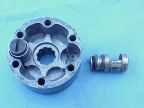 Note the cutout in the locking pin. When the pin is locked the cutout is rotated to the
outside edge of the hub and then the drive gear can free wheel inside the hub. The locking
pin assembly consists of the pin, spring, seal (O-ring), and washer. The spring preloades
the locking pin down into a locked position (More on this later). The O-ring seals the
cam-lock and the washer prevents the spring from cutting into the soft brass face on the
locking pin when the pin is rotated.
Note the cutout in the locking pin. When the pin is locked the cutout is rotated to the
outside edge of the hub and then the drive gear can free wheel inside the hub. The locking
pin assembly consists of the pin, spring, seal (O-ring), and washer. The spring preloades
the locking pin down into a locked position (More on this later). The O-ring seals the
cam-lock and the washer prevents the spring from cutting into the soft brass face on the
locking pin when the pin is rotated.
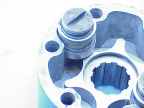 A close-up of the locking pin in the unlocked position allows you to observe how the drive
gear can rotate through the unlocked pin.
A close-up of the locking pin in the unlocked position allows you to observe how the drive
gear can rotate through the unlocked pin.
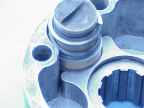 The same pin has been rotated into the locked position. In this position the drive gear is
locked in place and this transfers power to the wheel. Failure to lock both cams on a hub
could cause severe damage to the hub by transferring all of the power to one side of the
hub.
The same pin has been rotated into the locked position. In this position the drive gear is
locked in place and this transfers power to the wheel. Failure to lock both cams on a hub
could cause severe damage to the hub by transferring all of the power to one side of the
hub.
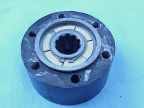 In this bottom view of the PLH you can see the nylon bearing that is the Achilles' Heel of
the hub. The drive gear rotates on this bearing. Apparently the bearing worked well and
didn't need to be stronger when new. However after 30 years or so, they are starting to
crack.
In this bottom view of the PLH you can see the nylon bearing that is the Achilles' Heel of
the hub. The drive gear rotates on this bearing. Apparently the bearing worked well and
didn't need to be stronger when new. However after 30 years or so, they are starting to
crack.
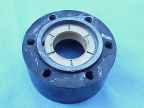 Here is the bearing with the
drive gear removed.
Here is the bearing with the
drive gear removed.
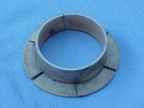 Here is the bearing removed
from the hub. It looks pretty good at first glance.
Here is the bearing removed
from the hub. It looks pretty good at first glance.
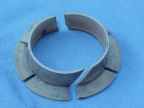 But in this view its condition takes on a different light. The straight cut is factory
original but the one in the back is not. Even with the bearing cracked in half, the hub
still works fine.
But in this view its condition takes on a different light. The straight cut is factory
original but the one in the back is not. Even with the bearing cracked in half, the hub
still works fine.

 The old
WARN Hubs, that I used to replace my Cutlass Hubs, have a set of caged needle bearings in
the place of the nylon bearing. This gives you a pretty good idea of the difference in
quality. If this bearing had been made of brass or bronze I think it would have been a lot
better. I had no idea where to find new bearing for these hubs, so I changed to the WARN
Hubs. I could have bought a new set of hubs but new parts on an old truck look funny to
me. I bought these WARNs are off of a 1949 Willys Pickup that was on its way to the
junkyard.
The old
WARN Hubs, that I used to replace my Cutlass Hubs, have a set of caged needle bearings in
the place of the nylon bearing. This gives you a pretty good idea of the difference in
quality. If this bearing had been made of brass or bronze I think it would have been a lot
better. I had no idea where to find new bearing for these hubs, so I changed to the WARN
Hubs. I could have bought a new set of hubs but new parts on an old truck look funny to
me. I bought these WARNs are off of a 1949 Willys Pickup that was on its way to the
junkyard.
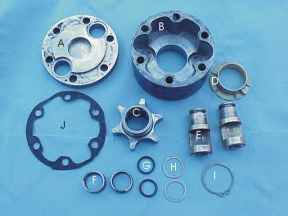 Here is a photo of the
individual parts of the hub. If the plastic ring is still usable like mine then you can
just replace the o-rings and make a set of gaskets to seal it up. Note the complex design
of the homemade gasket. It has to be cut his way to prevent the center hub from catching
on the gasket. I learned this the hard way. My bottom gasket did not survive the removal
so it isn't in the picture.
Here is a photo of the
individual parts of the hub. If the plastic ring is still usable like mine then you can
just replace the o-rings and make a set of gaskets to seal it up. Note the complex design
of the homemade gasket. It has to be cut his way to prevent the center hub from catching
on the gasket. I learned this the hard way. My bottom gasket did not survive the removal
so it isn't in the picture.
| A. Cover |
C. Drive Gear |
E. Lock Pins |
G. Seals |
I. Retaining Ring |
| B. Housing |
D. Nylon Bearing |
F. Springs |
H. Flat Washers |
J. Top Gasket |
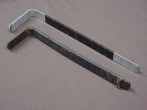 I decided to
make a new set of control keys. I used a piece of 3/4" bar steel. They were cut to
about 14" long and then the last 4" were bent over at a 90-degree angle. I put a
quarter on the end and drew a circle on the bar stock. The circle was used to grind the
end into a smooth curve. I chose a quarter because it fit the curve in the locking cam
perfectly.
I decided to
make a new set of control keys. I used a piece of 3/4" bar steel. They were cut to
about 14" long and then the last 4" were bent over at a 90-degree angle. I put a
quarter on the end and drew a circle on the bar stock. The circle was used to grind the
end into a smooth curve. I chose a quarter because it fit the curve in the locking cam
perfectly.
REMOVAL AND DISASSEMBLY PROCEDURES
The first step in removing the Cutlass Hub is to remove the six bolts holding the Cover
in place.
Remove the cover. The brass Locking Pins may or may not come off with the cover, it
doesn't matter.
Using snap-ring pliers, remove the snap-ring from the axle stub. Now the rest of the
hub will come off.
If the Locking Pins stayed inside the hub, you can remove them now.
You may need to rotate the Drive Gear to release the Locking Pins.
Remove the Locking Pin Springs and Washers.
The Seals should be removed and replaced. The seals are nothing more than O-rings that
can be purchased in most parts houses.
Turn the Housing upside down and remove the Retaining Ring from the drive gear.
Remove the Drive Gear from the front and the Nylon Bushing from the rear.
INSPECTION PROCEDURES
Remove all grease and dirt from the parts and inspect for damage.
1. Inspect the cover and housing for cracks and chips.
2. Inspect the Drive Gear and Locking Pins for excessive wear. The Locking Pins have a
cam lobe on the bottom that if worn away will prevent the Locking Pins from locking in
place. Fit the Pins into the Housing and ensure that they turn smoothly. The outside end
of the Locking Pins has a curved slot cut into it. If it needs to be repaired, you can do
it with a Drimal tool.
3. Inspect the Locking Pin Springs to ensure the are not broken and that they will not
bind on the Pins.
4. Inspect the Nylon Bearing for cracks. If it is only broken in half it can still be
used but if it is crumbled, some type of replacement will be needed. I am trying to have
some brass or bronze bushings made for these hubs. If I am successful, I will post it
here.
5. The Seals should be replaced to prevent grease from escaping the hub and to keep
moisture out.
INSTALLATION PROCEDURES
New gaskets are not available so homemade gaskets will need to be made. The bottom
gasket is fairly easy to make because it doesn't have any compound curves. The top gasket
must be cut to allow the center hub to move freely inside the hub housing, without hitting
on the gasket.
Slide the Nylon Bearing inside the Housing from the backside.
Slide the Drive Gear into the Housing from the front side and install the Drive Gear
Retaining Ring.
Slide the Locking Pin Washers onto the Pins then slide on the Locking Pin Springs.
Install the Locking Pins into the Housing with the openings toward the middle.
Rotate the Drive Gear until it engages the Locking Pins. This will hold them in place
until the cover plate can be installed.
Fit the bottom gasket onto the Housing and the top gasket onto the Cover.
Slide the Housing over the axle stub (No force should be needed) and install the snap
ring.
Install the Cover and six bolts. Cross torque the bolts to prevent the hub from
binding.
CUTLASS HUB ORIGINAL BOX
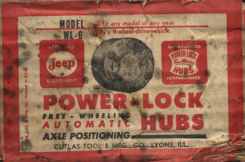 Now someone has
even provided a picture of the original Cutlass Hub box label. This is great. For a
larger, more detailed picture you can click on the picture.
Now someone has
even provided a picture of the original Cutlass Hub box label. This is great. For a
larger, more detailed picture you can click on the picture.
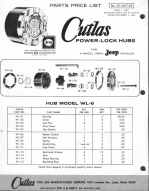 As if that wasn't enough Jeff
Bonno was kind enough to supply me with this wonderful scan of an illustrated parts
breakdown of this hub and another Cutlass Hub. For a nice viewable picture click on
the thumbnail. For a really large printable file, you can click here.
As if that wasn't enough Jeff
Bonno was kind enough to supply me with this wonderful scan of an illustrated parts
breakdown of this hub and another Cutlass Hub. For a nice viewable picture click on
the thumbnail. For a really large printable file, you can click here.
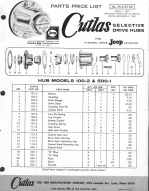 Here is the other Cutlass Hub.
And here is the really large printable file
for it too.
Here is the other Cutlass Hub.
And here is the really large printable file
for it too.
You can find the rest of my web pages here
 The PLH is
locked and unlocked using the angled tool in the picture known a control key. Each end of
the tool is rounded to fit into the curved slots in the top of each locking pin on the
hub. The locking pins have arrows to determine if they are locked or unlocked. When the
arrows point out the hub is unlocked, when they point in it is locked. The hubs should be
locked before engaging the four-wheel drive so that the axle shaft can be turned
internally. Failure to lock the hubs prior to engaging the four-wheel drive usually causes
the hub to bind and prevents locking. The Hub has these instructions printed on the face:
The PLH is
locked and unlocked using the angled tool in the picture known a control key. Each end of
the tool is rounded to fit into the curved slots in the top of each locking pin on the
hub. The locking pins have arrows to determine if they are locked or unlocked. When the
arrows point out the hub is unlocked, when they point in it is locked. The hubs should be
locked before engaging the four-wheel drive so that the axle shaft can be turned
internally. Failure to lock the hubs prior to engaging the four-wheel drive usually causes
the hub to bind and prevents locking. The Hub has these instructions printed on the face:













